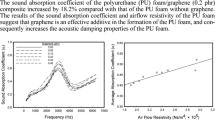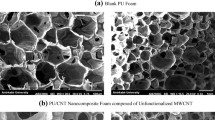Abstract
This study examines the multiscale acoustic properties of sound-absorbing polyurethane (PU) foam impregnated with graphene oxide (GO). GO impregnation into the PU foam was achieved through a vacuum-assisted process. The effects of GO impregnation on the macroscopic acoustic behavior, transport parameters, and sound absorption coefficients were investigated. Scanning electron microscopy images revealed that the impregnated GO enveloped the open pores within the porous structure. Geometric parameters derived from the microstructural observations were used to perform acoustic simulations. Models with partially open cells could be used to accurately predict the transport parameters and sound absorption coefficients of foams with low levels of GO impregnation. For foams with high levels of GO impregnation, it was necessary to incorporate closed cells into the model, which significantly enhanced the prediction accuracy for the transport parameters and sound absorption coefficients. This study advances our understanding of the acoustic properties of GO-impregnated PU foams and will be beneficial for develo** more effective sound-absorbing materials.
Graphical abstract
Acoustical characterization of graphene oxide impregnated polyurethane foam

















Similar content being viewed by others
References
M.E. Delany, E.N. Bazley, Acoustical properties of fibrous absorbent materials. Appl. Acoust. 3(2), 105–116 (1970). https://doi.org/10.1016/0003-682X(70)90031-9
Y. Miki, Acoustical properties of porous materials-Modifications of Delany-Bazley models. J. Acoust. Soc. Jpn. (E) 11(1), 19–24 (1990). https://doi.org/10.1250/ast.11.19
D.L. Johnson, J. Koplik, R. Dashen, Theory of dynamic permeability and tortuosity in fluid-saturated porous media. J. Fluid Mech. 176, 379–402 (1987). https://doi.org/10.1017/S0022112087000727
Y. Champoux, J.F. Allard, Dynamic tortuosity and bulk modulus in air-saturated porous media. J. Appl. Phys. 70, 1975–1979 (1991). https://doi.org/10.1063/1.349482
D. Lafarge, P. Lemarinier, J.F. Allard, V. Tarnow, Dynamic compressibility of air in porous structures at audible frequencies. J. Acoust. Soc. Am. 102(4), 1995–2006 (1997). https://doi.org/10.1121/1.419690
J.G. Gwon, S.K. Kim, J.H. Kim, Sound absorption behavior of flexible polyurethane foams with distinct cellular structures. Mater. Des. 89, 448–454 (2016). https://doi.org/10.1016/j.matdes.2015.10.017
R. Verdejo, R. Stämpfli, M. Alvarez-Lainez, S. Mourad, M.A. Rodriguez-Perez, P.A. Brühwiler, M. Shaffer, Enhanced acoustic dam** in flexible polyurethane foams filled with carbon nanotubes. Compos. Sci. Technol. 69, 1564–1569 (2009). https://doi.org/10.1016/j.compscitech.2008.07.003
S.H. Baek, J.H. Kim, Polyurethane composite foams including silicone-acrylic particles for enhanced sound absorption via increased dam** and frictions of sound waves. Compos. Sci. Technol. 198, 108325 (2020). https://doi.org/10.1016/j.compscitech.2020.108325
B.S. Kim, J. Choi, Y.S. Park, Y. Qian, S.E. Shim, Semi-rigid polyurethane foam and polymethylsilsesquioxane aerogel composite for thermal insulation and sound absorption. Macromol. Res. 30(4), 245–253 (2022). https://doi.org/10.1007/s13233-022-0026-8
S.E. Samaei, U. Berardi, H.A. Mahabadi, P. Soltani, E. Taban, Optimization and modeling of the sound absorption behavior of polyurethane composite foams reinforced with kenaf fiber. Appl. Acoust. 202, 109176 (2023). https://doi.org/10.1016/j.apacoust.2022.109176
J.M. Kim, D.H. Kim, J. Kim, J.W. Lee, W.N. Kim, Effect of graphene on the sound dam** properties of flexible polyurethane foams. Macromol. Res. 25(2), 190–196 (2017). https://doi.org/10.1007/s13233-017-5017-9
J.H. Lee, I. Jung, Tuning sound absorbing properties of open cell polyurethane foam by impregnating graphene oxide. Appl. Acoust. 151, 10–21 (2019). https://doi.org/10.1016/j.apacoust.2019.02.029
J.H. Lee, J.H. Kim, Y.J. Shin, J.H. Jeon, Y.J. Kang, I. Jung, Multilayered graphene oxide impregnated polyurethane foam for ultimate sound absorbing performance: Algorithmic approach and experimental validation. Appl. Acoust. 203, 109194 (2023). https://doi.org/10.1016/j.apacoust.2022.109194
J.H. Oh, J.E. Kim, H.R. Lee, Y.J. Kang, I.K. Oh, Directionally antagonistic graphene oxide-polyurethane hybrid aerogel as a sound absorber. ACS Appl. Mater. Interfaces 10(26), 22650–22660 (2018). https://doi.org/10.1021/acsami.8b06361
J.H. Oh, H.R. Lee, S. Umrao, Y.J. Kang, I.K. Oh, Self-aligned and hierarchically porous graphene-polyurethane foams for acoustic wave absorption. Carbon 147, 510–518 (2019). https://doi.org/10.1016/j.carbon.2019.03.025
S.S. Yang, J.W. Lee, J.H. Kim, Y.J. Kang, Effect of thermal aging on the transport and acoustic properties of partially reticulated polyurethane foams. J. Acoust. Soc. Am. 152(4), 2369–2381 (2022). https://doi.org/10.1121/10.0014913
T.G. Zieliński, R. Venegas, C. Perrot, M. Červenka, F. Chevillotte, K. Attenborough, Benchmarks for microstructure-based modelling of sound absorbing rigid-frame porous media. J. Sound Vib. 483, 115441 (2020). https://doi.org/10.1016/j.jsv.2020.115441
Y. Salissou, R. Panneton, Pressure/mass method to measure open porosity of porous solids. J. Appl. Phys. 101, 124913 (2007). https://doi.org/10.1063/1.2749486
Z.E.A. Fellah, S. Berger, W. Lauriks, C. Depollier, C. Aristegui, J.-Y. Chapelon, Measuring the porosity and the tortuosity of porous materials via reflected waves at oblique incidence. J. Acoust. Soc. Am. 113, 2424–2433 (2003). https://doi.org/10.1121/1.1567275
ASTM C522-03: Standard Test Method for Airflow Resistance of Acoustical Materials (ASTM International, West Conshohocken, PA, 2016)
L. Jaouen, E. Gourdon, P. Glé, Estimation of all six parameters of Johnson-Champoux-Allard-Lafarge model for acoustical porous materials from impedance tube measurements. J. Acoust. Soc. Am. 148(4), 1998–2005 (2020). https://doi.org/10.1121/10.0002162
S.F. de Sá, J.L. Ferreira, A.S. Matos, R. Macedo, A.M. Ramos, A new insight into polyurethane foam deterioration–the use of Raman microscopy for the evaluation of long-term storage conditions. J. Raman Spectrosc. 47, 1494–1504 (2016). https://doi.org/10.1002/jrs.4984
J.H. Park, K.S. Minn, H.R. Lee, S.H. Yang, C.B. Yu, S.Y. Pak, C.S. Oh, Y.S. Song, Y.J. Kang, J.R. Youn, Cell openness manipulation of low density polyurethane foam for efficient sound absorption. J. Sound Vib. 406, 224–236 (2017). https://doi.org/10.1016/j.jsv.2017.06.021
Acknowledgements
This research was supported by the Institute of Engineering Research at Seoul National University and a grant from Kyung Hee University in 2020 (KHU-20201096).
Author information
Authors and Affiliations
Corresponding authors
Ethics declarations
Conflict of interest
The authors declare that they have no competing financial interests or personal relationships that may have influenced the work reported in this paper.
Additional information
Publisher's Note
Springer Nature remains neutral with regard to jurisdictional claims in published maps and institutional affiliations.
Rights and permissions
Springer Nature or its licensor (e.g. a society or other partner) holds exclusive rights to this article under a publishing agreement with the author(s) or other rightsholder(s); author self-archiving of the accepted manuscript version of this article is solely governed by the terms of such publishing agreement and applicable law.
About this article
Cite this article
Yang, S.S., Jung, I. & Kang, Y.J. Multiscale acoustical study on graphene oxide impregnated polyurethane foam. Macromol. Res. (2024). https://doi.org/10.1007/s13233-024-00281-7
Received:
Revised:
Accepted:
Published:
DOI: https://doi.org/10.1007/s13233-024-00281-7




